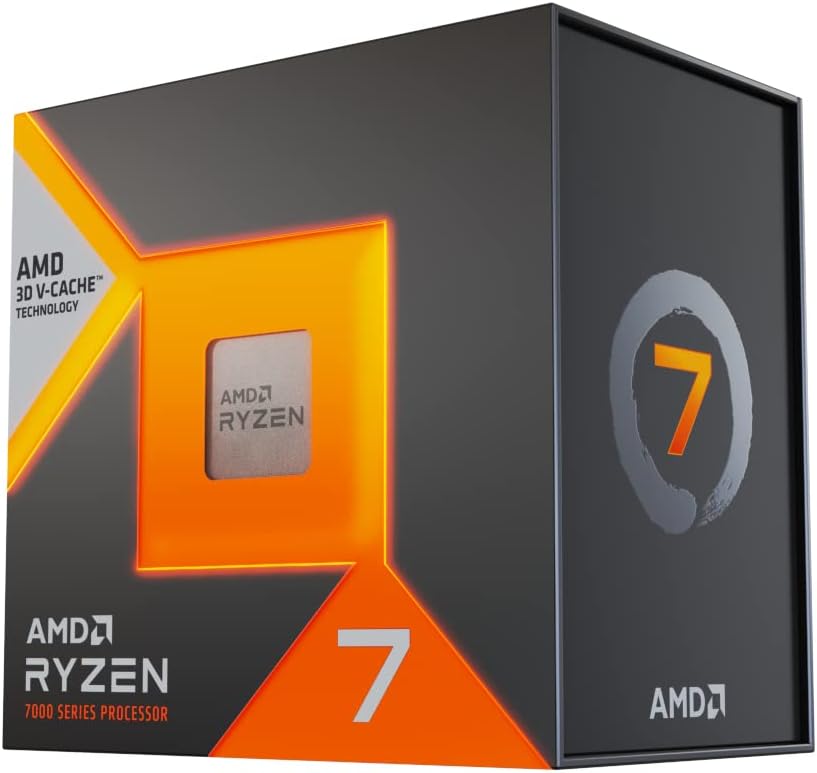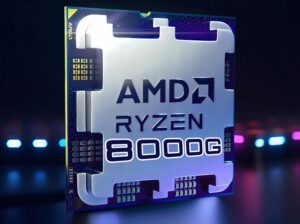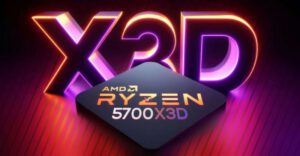Gaming Dominance. The AMD Ryzen 7 7800X3D is a high-performance desktop processor that stands out in the current market for its impressive specifications and technological advancements, particularly for gaming applications.
Ryzen 7 7800X: Key Features and Specifications
- Core Configuration: The Ryzen 7 7800X3D is an 8-core, 16-thread processor, leveraging AMD’s Zen 4 architecture. This core configuration is optimized for high-performance computing tasks and efficient multitasking.
- Clock Speeds: It operates at a base clock of 4.2 GHz and can boost up to 5.0 GHz under certain workloads. This high frequency range is beneficial for demanding applications and games.
- Cache Memory: One of the standout features is its substantial L3 cache size of 96 MB, which includes 64 MB of AMD’s innovative 3D V-Cache technology. This large cache enhances data retrieval speed, significantly benefiting gaming performance.
- Thermal Design Power (TDP): The TDP is rated at 120 W, indicating its power consumption under maximum theoretical load.
- Memory Support: It supports DDR5 memory with a rated speed of 5200 MT/s, catering to high-speed memory configurations.

When comparing with the AMD Ryzen 9 7900X3D, it’s important to note that while both processors share similar architectural features, including the 3D V-Cache technology, they are targeted towards different segments of the market. The Ryzen 9 7900X3D, with more cores and threads, is positioned towards users requiring higher multi-threaded performance.
The AMD Ryzen 7800X3D is particularly noted for its gaming prowess. It delivers exceptional gaming performance, often surpassing more expensive CPUs in this domain. This performance advantage is largely attributed to its advanced cache memory configuration.
The R7 7800X3D’s competitive pricing also makes it an attractive option for gamers and general users seeking a balance between cost and high-end performance.
In the context of the AMD Ryzen 7 7800X3D, it’s clear that AMD has focused heavily on enhancing gaming performance. The processor’s efficient power management, coupled with its significant cache size, positions it as a top choice for gaming enthusiasts.
In conclusion, the Ryzen 7 7800X3D represents AMD’s commitment to providing high-performance, gaming-optimized CPUs. Its combination of high clock speeds, large cache, and advanced memory support make it a formidable choice for both gamers and power users.
The Amd ryzen 7800x3d is a notable processor in the gaming CPU market. It features 8 cores and 16 threads, along with a substantial 96MB L3 cache due to its 3D V-Cache technology. This tech significantly enhances its performance, particularly in gaming scenarios. However, it’s important to note that while it excels in gaming, its performance in multi-threaded and non-gaming tasks may not be as impressive compared to some other CPUs in its category. Additionally, the Ryzen 7 7800X3D is designed to offer a balance between power efficiency and high performance in gaming.
5800x3d vs 7800x3d
The AMD Ryzen 7 5800X3D and Ryzen 7 7800X3D are both high-performance desktop processors, each with unique features and specifications. Here’s a detailed comparison based on your request:
7800X3D. General Specifications
- Cores and Threads: Both have 8 cores and 16 threads, offering efficient multitasking and performance in demanding applications.
- Architecture: The 5800X3D is based on the Vermeer (Zen 3) architecture, while the 7800X3D uses the newer Raphael (Zen 4) architecture.
- Launch and Price: The 5800X3D was released in Q4/2020, whereas the 7800X3D launched in Q1/2023. The initial retail price for the 7800X3D was $449.
7800X3D Performance
- Base and Turbo Clock Speed: The 5800X3D has a base clock of 3.4 GHz and a turbo boost of 4.5 GHz. In contrast, the 7800X3D has a higher base clock of 4.2 GHz and can boost up to 5 GHz.
- Cache: Both processors have a shared L3 cache of 96 MB. The 7800X3D features a larger L2 cache of 1 MB per core compared to the 5800X3D’s 512K per core.
Memory and Storage
- Supported Memory Types: The 5800X3D supports DDR4-3200, while the 7800X3D supports the faster DDR5-5200.
- Maximum Memory and Channels: Both processors can handle up to 128 GB of memory across 2 memory channels.
Power and Thermal Design
- TDP (Thermal Design Power): The 5800X3D has a TDP of 105 W, whereas the 7800X3D has a slightly higher TDP of 120 W, indicating a need for more efficient cooling solutions for the latter.
Integrated Graphics
- Graphics Support: The 7800X3D features an integrated Radeon Graphics solution, whereas the 5800X3D does not have an integrated GPU.
Compatibility and Connectivity
- Socket Compatibility: The 5800X3D uses the AM4 socket, while the 7800X3D is compatible with the newer AM5 socket.
- PCIe Version: The 7800X3D supports PCIe 5.0, offering faster data transfer rates compared to the 5800X3D’s PCIe 4.0 support.
7800X3D. Technological Features
- Instruction Set Extensions: Both CPUs support a wide range of instruction sets like SSE, AVX, and AES-NI, essential for advanced computing tasks.
Additional Notes
- Maximum Operating Temperatures: The maximum core temperature for the 5800X3D is 90°C, while specific temperature data for the 7800X3D was not available.
- Transistor Count and Die Size: The 7800X3D is built using 11,270 million transistors and has a die size of 71 mm².
The Ryzen 7 7800X3D, with its newer Zen 4 architecture, higher clock speeds, support for faster DDR5 memory, and integrated graphics, represents a significant upgrade over the Ryzen 7 5800X3D. However, this comes with increased power consumption and the requirement for a newer socket type (AM5), which could necessitate a motherboard upgrade. The choice between these two processors will depend on your specific performance needs, budget, and existing system compatibility.
Ryzen 9000.AM5 platform will be supported Zen 6
The AMD Ryzen 7 7800X3D processor is available at varying prices depending on the region and retailer. In the U.S., the recommended retail price (MSRP) is $449, as reported by several sources including Tom’s Hardware and Dexerto. However, the actual market price can fluctuate, with some historical lows around $348.94 and highs reaching $637.7.
When considering where to purchase the Ryzen 7 7800X3D, there are several options in both the U.S. and the UK. In the U.S., retailers like Best Buy, Amazon, B&H, Micro Center, and Newegg are recommended, while in the UK, Amazon UK, Overclockers, Ebuyer, Scan, CCL, AWD-IT, Box, and AMD UK are among the options. Notably, some retailers offer the processor bundled with additional items like the game “Star Wars Jedi: Survivor.”
For the best deal, it’s recommended to compare prices and available bundles among these retailers. In the UK, prices range from £424 to £440, with some including the aforementioned game bundle. In the U.S., B&H Photo Video offers a lower price of $419 in the cart, while others like Amazon US, Antonline, Best Buy, and Newegg list it at $449, sometimes also with the game bundle.
To summarize, the Ryzen 7 7800X3D is a high-end CPU ideal for gamers and PC enthusiasts. Its pricing varies by region and retailer, with the U.S. MSRP at $449 and UK pricing around £439. For the best purchase, it’s advisable to check multiple retailers for the most competitive pricing and bundles.



